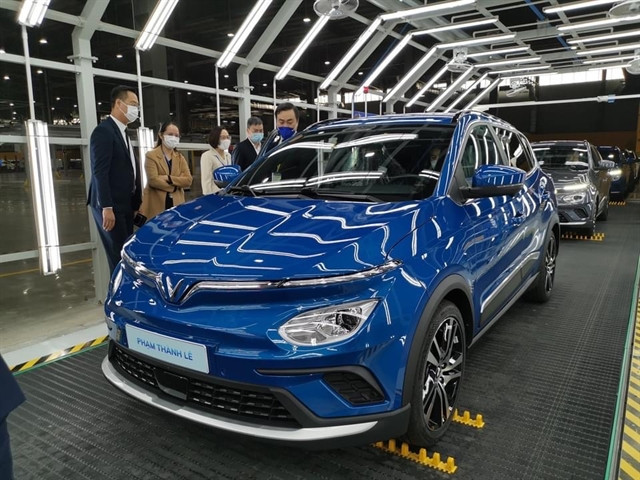 VF e34, the first model developed by Vietnamese automaker VinFast, has seen a sudden sales surge and is ranked 8th in the list of best-selling cars in the Vietnamese market in July 2022. (Photo muaxegiatot.vn)
VF e34, the first model developed by Vietnamese automaker VinFast, has seen a sudden sales surge and is ranked 8th in the list of best-selling cars in the Vietnamese market in July 2022. (Photo muaxegiatot.vn)Experts believe that Vietnamese people have gradually opened their hearts togreen cars. In the next few years, when traffic infrastructure and e-vehiclecharging stations are widely available, electric vehicles will be chosen bylocal users.
Vietnam’s middle class is growing and live in urban areas while e-vehicles meetthe criteria of smart cities, thus people are shifting to green cars that helpreduce environmental pollution.
According to experts, the electric car segment has begun to diversify with aseries of outstanding cars, from popular to luxury. Vietnamese automakerVinFast has entered the e-vehicles market at a “golden time” as sales volume ofelectric vehicles has begun to increase.
VinFast has entered countries where the popularity of e-vehicles is sharplyincreasing, such as the US, France, Germany, the Netherlands and Canada.
The Vietnam Automobile Manufacturers Association (VAMA) reports that the VFe34, the first model developed by Vietnamese automaker VinFast, has seen asudden sales surge and is ranked 8th in the list of best-selling cars in theVietnamese market in July 2022.
In June alone, VinFast sold a total of 2,141 vehicles, reflecting a transitionfrom petrol to electric cars. However, it saw sluggish sales in August due to alack of components.
According to a recent report on Vietnam’s electric car market published by theVietnam Petroleum Institute, Vietnam has great potential to develop thissegment. If the Government implements supporting policies in a timely manner, Vietnamcan take the lead in electric car development in Southeast Asia.
The Vietnam Petroleum Institute reports that Vietnam's automobile market stillshows a lot of room to grow as car ownership remained low at 23 cars per 1,000people while it is 1 in 10 people in Thailand and 1 in 20 in Malaysia.
Vietnam is a land of great potential with a large population of nearly 100million people and an undeveloped electric vehicle market. Meanwhile, electricvehicles are becoming a global trend and revenue from the electric vehiclesegment is growing at 10 per cent a year, according to car experts.
They predict revenue from the electric vehicle market by 2025 will reach about 60billion USD.
VAMA has also proposed three scenarios for electric vehicles in Vietnam, withall vehicles being electric by either 2035, 2045 or 2050.
According to the International Energy Agency, electric vehicle sales are oncourse to hit an all-time high this year, but more work is needed in othersectors to put the planet on course for net-zero emissions by 2050.
On the EV front, the IEA said global sales doubled in 2021 to represent nearlynine per cent of the car market. Looking forward, 2022 was expected to seeanother all-time high for electric vehicle sales, lifting them to 13% of totallight duty vehicle sales globally.
The IEA has previously stated that electric vehicle sales hit 6.6 million in2021. In the first quarter of 2022, EV sales came to 2 million, a 75% increasecompared to the first three months of 2021.
Despite the outlook for EVs, the IEA separately noted that they were “not yet aglobal phenomenon. Sales in developing and emerging countries have been slowdue to higher purchase costs and a lack of charging infrastructureavailability.”
According to the IEA, sustained policy support is the main pillar. Publicspending on subsidies and incentives for EVs nearly doubled in 2021 to nearly 30billion USD. A growing number of countries have pledged to phase out internalcombustion engines or have ambitious electric vehicle targets for the comingdecades./.




























